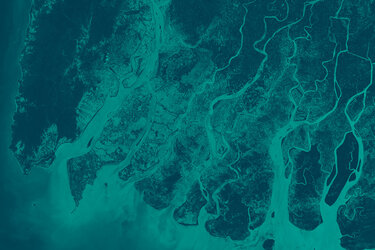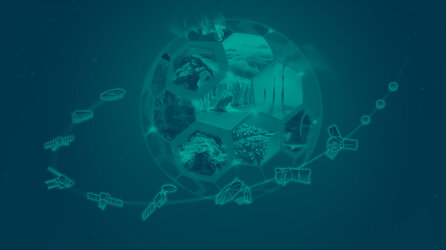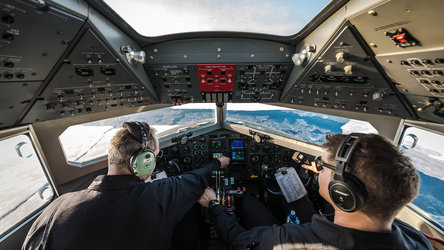Harmony in the Wadden
An important milestone in the preparation of ESA’s tenth Earth Explorer candidate satellite mission, Harmony, has been reached thanks to two aircraft flying in tight formation over the Dutch Wadden Islands collecting key data on sea state and currents. The main purpose of this tricky airborne experiment is to mimic the geometry at which the Harmony satellites will measure various aspects of ocean dynamics to understand how air and the ocean surface interact, which, in turn, will improve weather prediction and climate models.
The Harmony candidate mission concept is currently undergoing the last stages of preparation prior to being put forward as the Earth Explorer 10 flagship mission. A User Consultation Meeting will be held on 5 July 2022, after which a decision on implementation of the mission is expected in September.
Developed within ESA’s FutureEO programme, Earth Explorers are pioneering research missions that show how new measuring techniques can lead to new scientific findings about our planet. Advancing science and technology, they address questions that have direct bearings on societal issues such as the availability of food, water, energy and resources, public health and climate change.

The Harmony concept would comprise two identical satellites orbiting in convoy with a Copernicus Sentinel-1 radar satellite. Each Harmony satellite is being designed to carry a receive-only synthetic aperture radar as its main instrument.
Over land, Harmony would provide data to measure small shifts in the shape of the land surface, such as those resulting from earthquakes and volcanic activity, and therefore it will contribute to risk monitoring. It would also provide new information to study 3D deformation and flow dynamics of glaciers at the rapidly changing marginal zones of the ice sheets for a better understanding of the impact of ice mass loss on sea-level rise.
Over the ocean, Harmony would provide simultaneous measurements of surface wind, currents and temperature, as well as ocean waves – and the recent airborne experiment over the Wadden Islands focused on how Harmony would do just this.
Harmony’s Principal Investigator, Paco López-Dekker, from the Delft University of Technology in the Netherlands, explained, “One of the fundamental difficulties in modelling weather and climate is that we must account for processes ranging from submeter scales up to global scales, with lifetimes ranging from seconds to months, or even years.

“Processes at different scales are also coupled. Global and regional weather and climate cannot be understood without accounting for, for example, the exchange of heat, momentum and gases at the air–sea interface, which are mainly the result of small-scale processes such as atmospheric boundary-layer turbulence, upper ocean eddies and fronts and ocean waves.
“Since it is impossible to simulate the full range of scales numerically, we rely on simplified models for what happens at the small, unresolved, scales. Developing and improving these small-scale models depends heavily on observations – which is where Harmony comes into play.”
ESA’s Björn Rommen added, “Harmony is designed to provide surface-wind stress, surface currents, ocean waves, and sea-surface temperature data at different scales by observing the ocean surface simultaneously from different directions with the satellites’ collocated radar and thermal imaging systems.
“This is done elegantly by orbiting one Harmony satellite a few hundred kilometres ahead of a Copernicus Sentinel-1 satellite and the other Harmony satellite behind Sentinel-1, in what we call a multi-static configuration.

“The experiment, WaddenSAR, over the Wadden Islands in the Netherlands is important as it helps to confirm our theoretical understanding of what the radar is going to measure.”
The critical, but tricky, part of the campaign therefore involved flying two aircraft in careful formation, one kilometre apart, to emulate the Harmony mission’s geometry in collecting data on sea-surface currents and sea state.
ESA Campaign Scientist, Julia Kubanek, said, “We chose the Wadden Sea because there are strong tidal currents and variable winds. Although wind might not be a pilot’s best friend, we needed some so that the sea was a bit choppy. Fortunately, the weather was on our side and we completed all the flights and gathered the data we needed.
“Each aircraft carried a C-band synthetic aperture radar. To simulate the transmit–receive arrangement between Sentinel-1 and Harmony, one of the aircraft’s instruments could emit and receive radar signals to and from the sea surface, and one was a receive-only instrument.
“All in all, we had a very successful campaign. For example, we flew for well over five hours on one of the days in very good weather, crossing some key targets such as a ferry which carries a sensor and also a station that measures sea currents.

“We are now analysing all this data but we are already confident that the results are going to be of use to ESA’s Harmony mission.”
On behalf of ESA, the campaign was carried out by MetaSensing Radar Solutions, with support from Deltares, the Royal Netherlands Institute for Sea Research and the Paracentrum Texel.















 Germany
Germany
 Austria
Austria
 Belgium
Belgium
 Denmark
Denmark
 Spain
Spain
 Estonia
Estonia
 Finland
Finland
 France
France
 Greece
Greece
 Hungary
Hungary
 Ireland
Ireland
 Italy
Italy
 Luxembourg
Luxembourg
 Norway
Norway
 The Netherlands
The Netherlands
 Poland
Poland
 Portugal
Portugal
 Czechia
Czechia
 Romania
Romania
 United Kingdom
United Kingdom
 Slovenia
Slovenia
 Sweden
Sweden
 Switzerland
Switzerland



































